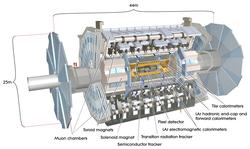-
FSP101-ATLAS
 Detektor
·
Detektor
·
Der ATLAS-DetektorThe ATLAS detector has been designed to exploit the full physics potential of the LHC. This includes the search for the origin of mass, searchesfor heavy W- and Z-like objects, supersymmetric particles, for compositness of the fundamental fermions as well as the investigation of CP violation in B-decays and detailed studies of the top quark. The ability to cope well with a broad variety of possible physics processes is expected to maximize the detector’s potential for the discovery of new, unexpected physics. A lot of different benchmark processes were used in formulating the basicprinciples of the detector. These can be summarized as following:
|
Impressum |
Datenschutzerklärung |
Erklärung zur Barrierefreiheit |
Kontakt |
Sitemap |
Seite empfehlen |
© 2025 Deutsches Elektronen-Synchrotron DESY


